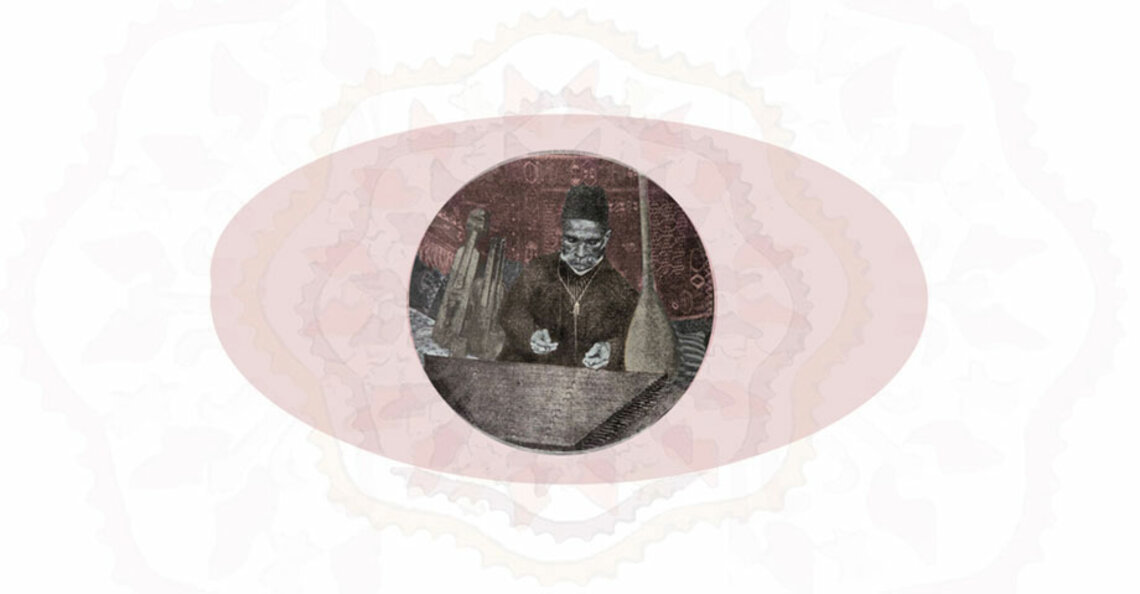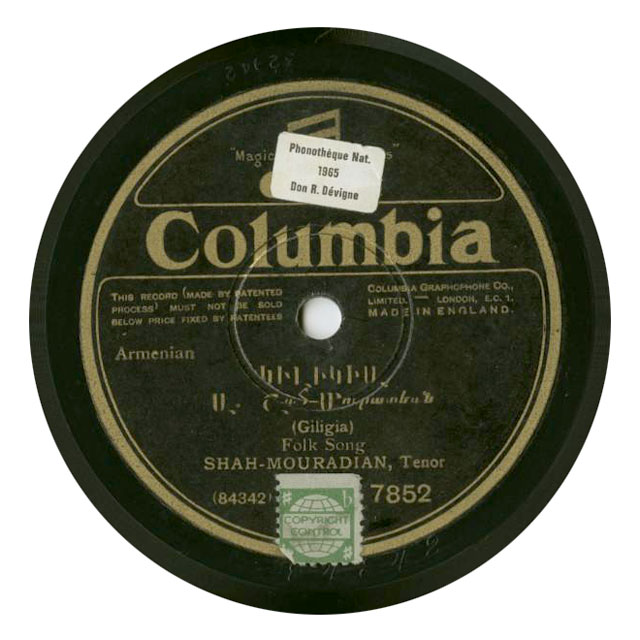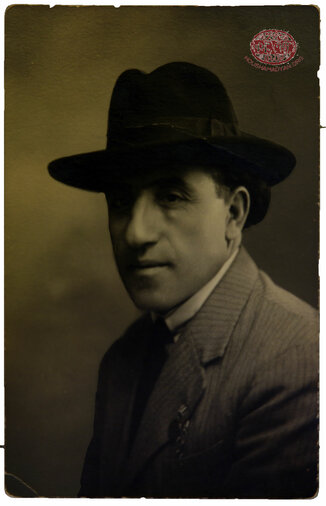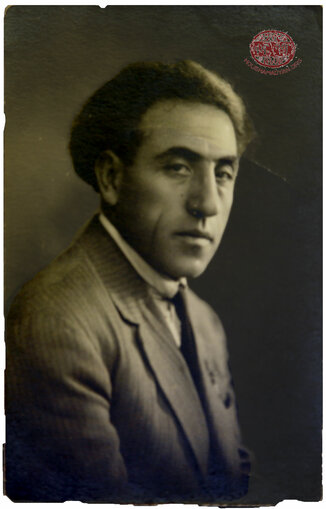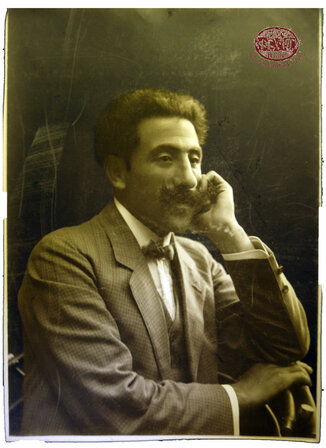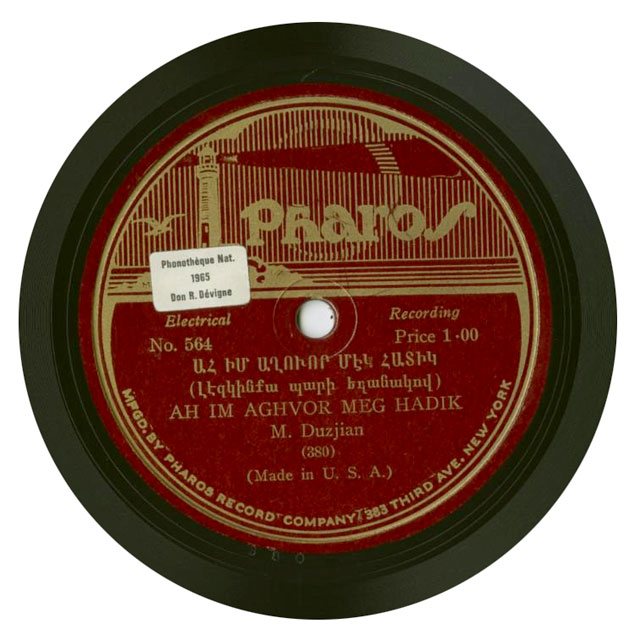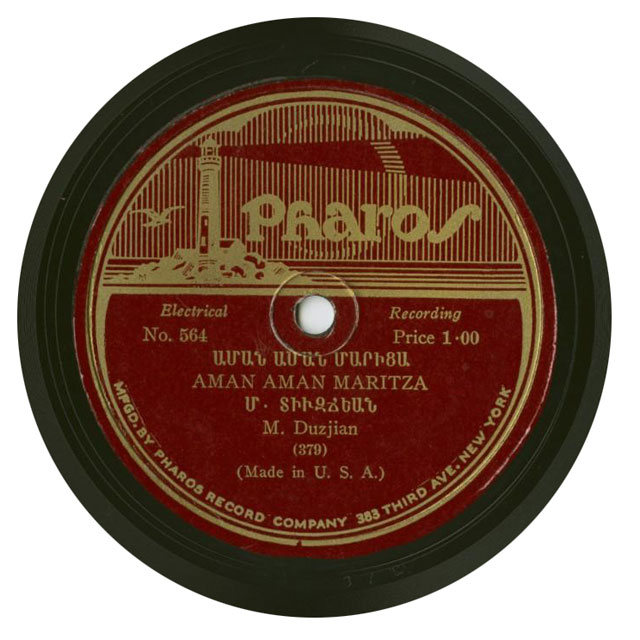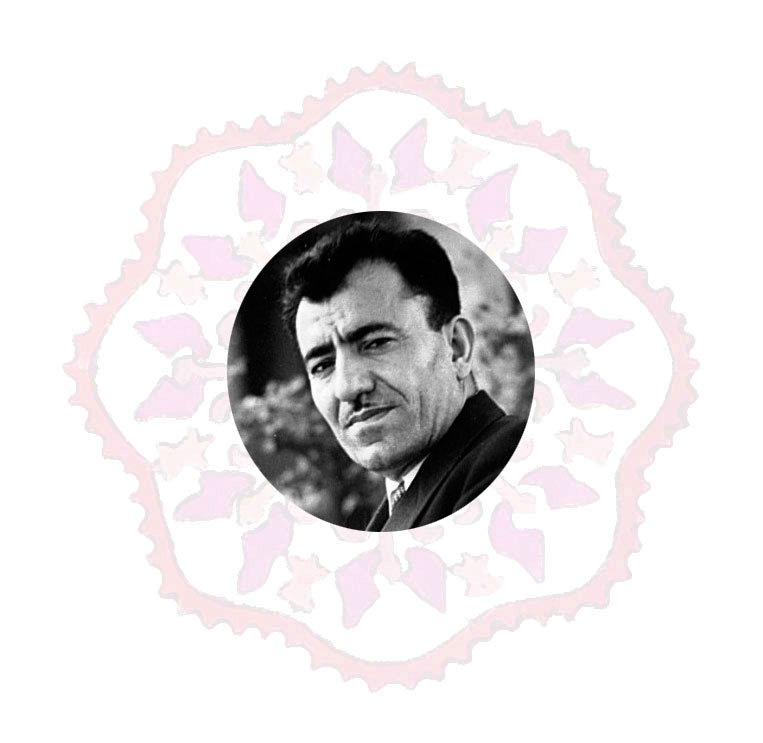Music gallery - II

Editor's note
It is Houshamadyan’s aim to try to understand and to introduce, as far as possible, the variegated and heterogeneous Ottoman Armenian world – in all the places where Armenians lived in the Ottoman Empire. It is simple for us to see the often great differences in Ottoman Armenian culture between one place and the next. We do not want to ignore this diversity that exists in the same community group. On the contrary, we consider it a different ingredient in the Ottoman Armenian legacy, and thus a subject worthy of study without bias.
It is the same in the field of the art of song. Armenians have not spoken or sung in Armenian everywhere in the Ottoman Empire. We find geographical regions in the Ottoman Empire where the local Armenians, different especially to those of the many places in the Armenian highlands, have lived less isolated lives or, over the centuries, found themselves to be in a minority situation. The impact of the social environment and cultural influences has also left its mark on the language and the songs these groups of Armenians used. For this reason there have been areas of Armenian settlement and towns and cities where the Armenians’ mother tongue has been Turkish, and the songs they have created and sung have been in that same language.
It is possible to say the same about the some of the musical instruments the Ottoman Armenians used. Some of them, like the ud (oriental lute) for example, have practically no place in contemporary Armenian music. But as we’ve already pointed out, Houshamadyan’s aim is not to wipe out or ignore these differences. We want to reconstruct a past that is as accurate as possible. Using this principle we will attempt to present the Ottoman Armenian just as he or she was, staying away from ideological, aesthetic or various politico-cultural influences.
We think that the list of songs presented below best defines the great diversity of Ottoman Armenian culture. In it we can find classical Armenian songs still heard on Armenian stages today. But there are also other songs whose tunes and the sounds of the instruments used may seem alien by those who admire contemporary Armenian music. In other words the collection of songs and singers are often incoherent and will be difficult to place within a general theme. But from our point of view, these songs also have a common denominator; they have been listened to and sung by Ottoman Armenians – in their home cities and towns or villages or, later, in the 1920s, outside the Ottoman Empire, in the newly-formed exile communities. This means, of course, that such songs have accompanied the Ottoman Armenians and have formed part of daily lives. Our aim is to give a place in our website pages to all such songs, knowing well that they all have their place in the Ottoman Armenians’ general legacy.

Dzove (The Sea)
Poem by Karekin Srvantsdiants, performed by T. Babikian
Ivan Aivazovsky, Among waves, 1898 (Source: ivan.evart.ru/jivopis/storm/pictures/sredi_voln)
Karekin Srvantsdiants –born Ohaness– was born in 1840 in the Aykesdan neighborhood of Van. He followed his primary education in Van. In 1857 he attends the Varak monastery’s seminary school. In 1864 he is ordained a priest and is called to duty in Van. In 1878, after the Russo-Turkish war, Srvantsdiants makes a tour of the Armenian–populated regions of the Empire. The impressions of these visits would later be published in his two-volume Toros Akhpar book (1878, 1879). In 1885, he is elected Prelate of Trabzon. His activities displease the authorities and under their pressure he is called to Istanbul, where he stays until his death in 1892. He also wrote Krots-prots (1874), Manana (1876), Hamov-Hodov (1884), and Hnots-norots (1874). In his work, Srvantsdiants highlights the daily provincial life of the Armenians, their traditions and folkloric poetry.
- Dzove hoknadz perpur pernin,
- Apin engadz ge heva,
- Jer aperits mege metin
- Dzovi vera ge sogha.
- Verke serdis ankun-andun
- Gyankits heru yem pakher,
- Guzem abrem vayri apum,
- Abrem menag, anenger.
- Asdghunk meg-meg yelan pazman
- Yergni peruz atorkum,
- Asdgheri bes yerkers yelan
- Hokus merayl khorkerum.
- Serdis larern derdum-derdunch
- Gyankes toshnadz yerketsin,
- Hove hevats munch ou mermunch,
- Asdghunk veras lur latsin.
- Ambern engan dzovi vren
- Hazar pernov chur khemin,
- Terav volorn kholor dzoven,
- Dzevats, nesdav tukh karin.
- Yes el kez bes, menig voror,
- Achers artsunk u derdum,
- Ge taparim volor-molor,
- Gyanki heru aperum...

Antsir Sev Amb/ Inchou Bingole Mdar
Pass on black cloud/Why did you enter Bingol
Performed by T. Babikian
(Source: en.wikipedia.org/wiki/Ivan_Aivazovsky)
These are songs that follow one another. The first one is Antsir Sev Amb (Pass on black cloud) whose lyrics were written by Hovhaness Hovhanessian (1864-1929). The second one is a popular song: Inchu Bingyole Mdar (Why did you enter Bingyol/Bingöl).
- Antsir sev amb
- Antsir sev amb im serdits,
- Patsvir yergink gabudag,
- Dkhur khavar tukhbi mech,
- Tsola karnan arekag.
- Togh badarvi tsurd tsemran
- Seko hanterts daghdgali,
- Yev shoghshogha penutyan
- Vosge jebid tsangali.
- Inchu Bingyole mdar?
- Inchu Bingyole mdar,
- Sari blbule mdar.
- Dle, Megon, de,
- Apon tekhgonde;
- Tekhgon, tekhgon, tekhgonde,
- Apon gonde, tegonde.
- Susam sembul,
- Baghi blbul,
- Inchu Garoyin arar,
- Ander u keri tarar.
(Source: gallica.bnf.fr / Bibliothèque nationale de France)

Giligia (Cilicia)
Lyrics by Nahabed Rusinian, music by Kapriel Yeranian, performed by Armenag Shahmuradian
- Yerpor patsvin trnern huso
- Yev mer yergren pakh da tsmer;
- Chknagh yergirn mer Armenio
- Yerp paylin yur kaghtsrig orer;
- Yerpor dzidzarn yur puyn tarna,
- Yerpor dzarern haknin derev;
- Tsangam desnel zim Giligia,
- Ashkharh vor ints yedur arev.
- Desi tashdere Syurio,
- Leyarn Lipanan yev yur mayrer;
- Desi zergirn Idalio,
- Venedig yev yur gondolner;
- Geghzi neman chik mer Gibrya,
- Yev voch meg vayr e artarev
- Keghetsig kan zim Giligia,
- Ashkharh vor ints yedur arev.
- Hasag me ga mer genats mech
- Ur amenayn ights gavardi,
- Hasag me ur hokin i dench
- Hishadagats yur garodi;
- Horjam knarn im tserdana,
- Siruyn dalov verchin parev,
- Yertam nnchel him Giligia,
- Ashkharh vor ints yedur arev.
Nahabed Rusinian was born in 1819, in the Efkere village of the Kayseri/Gesaria province. After following his primary education in the village school, in 1828 the family immigrates to Istanbul and settles in Scutari/Üsküdar. In 1840, he leaves for Paris to continue his education at the university and in 1849 he receives his medical degree. In 1851, he returns to Istanbul and participates in the development of the Armenian National Constitution of the Ottoman Empire. Rusinian was the personal doctor of Mehmed Fuad Pasha –a high-ranked Ottoman official– who was one of the main reformists of the Tanzimat period. During the Crimean war (1853-1856), Rusinian befriends Fuad Pasha in the Greek front. In 1860, Fuad Pasha is sent to Mount Lebanon for a special mission, where during inter-communal clashes, Maronites were massacred by Druzes. Rusinian also accompanied Fuad Pasha throughout the whole duration of this journey to Lebanon. It is during this stay that he visits the mountains of Lebanon, Cyprus and Cilicia, after which he writes the famous popular song Giligia. He dies in 1876 in Istanbul.
Kapriel Yeranian was born in 1827 in Istanbul. He is one of the publishers of the first Armenian music periodical, the “Knar Haygagan” (Armenian Lyre) review, which was published between 1857 and 1858. He later publishes “Knar Arevelian” (Oriental Lyre) (1861-1862). He is also the music composer of the songs “Hayasdan Yergir Trakhdavayr” (Armenia, the paradisiacal land), “Arik, Haygazounk” (Come, children of the Armenian people), and “Hay Abrink, Yeghpayrk” (Let’s live as Armenians, brothers). He dies in Istanbul in 1862.
Armenag Shahmuradian was the son of a blacksmith and was born in Mush, Eastern Anatolia in 1878. He received his education in the seminary of St Garabed monastery, Mush, then in the Holy Echmiadzin Kevorkian seminary, and finally in the Nersisian School in Tiflis (Tblisi). He was known as the ‘nightingale of Daron’. Shahmuradian was a student and friend of the famous Armenian ethnomusicologist Gomidas Vartabed. He received his musical education in Paris. He died in 1939 in Paris.
Giligia is an adaptation–translation of Frédéric Bérat’s (1801-1855) song “Ma Normandie” (My Normandy).

Akh im aghvor meg hadig (Oh my lovely one of a kind)
Performed by M. Duzjian
- Akh im aghvor meg hadig,
- Ge vari gor im serdig,
- Hay aghchig, sirun aghchig,
- Inch gella dur mi bachig.
- Sirdis khoren khosetsar,
- Minchev hima inch getsar,
- Ay dgha, sirun dgha,
- Meg bachigov inch gella.
- Tun ayretsir ints achov,
- Mare sirdes mi bachov,
- Yete mayret trame da,
- Sere gorhne (...).
- Yegur uze ints mormes,
- Chi da pakhchink tu yev yes,
- Yergu yeghink mi marmin,
- Lsoghn al gese amin.
(Source: gallica.bnf.fr / Bibliothèque nationale de France)

Aman aman Maritza!
Performed by M. Duzjian
- Khentsor munim kadzadz e,
- Khadzadz deghn al ardztadz e,
- Akhbares uzets chdvi,
- Ays im yaris dvadzn e.
- Aman aman aman Maritsa,
- Yes ku dardet ayretsa,
- Aman aman aman Maritsa,
- Yes ku dardet varetsa.
- Yela partser lernere,
- Serdis tsave perner e,
- Yergu siradz yarere,
- Irar chen dar marere.
- Aman aman aman Maritsa,
- Yes ku dardet ayretsa,
- Aman aman aman Maritsa,
- Yes ku dardet varetsa.
- Tutin dzare boyoke,
- Tut chi gera oroket,
- (…) dun dari,
- Yar chi desa oroket.
- Aman aman aman Maritsa,
- Yes ku dardet ayretsa,
- Aman aman aman Maritsa,
- Yes ku sirov varetsa.
- Yeler em partser sare,
- Ge tidem vari tsore,
- Tever chunim vor terchim,
- Bid danim yaris kove.
- Aman aman aman Maritsa,
- Yes ku dardet ayretsa,
- Aman aman aman Maritsa,
- Yes ku dardet varetsa.
(Source: gallica.bnf.fr / Bibliothèque nationale de France)

Usge gu kas veri vana
Performed by Roger Mgrdichigan (Gomidas Band)
- Usge gu kas veri Vana(?)
- Derdet em (...)
- Bachig me dur mart chimana,
- Yar gyulyum djan e,
- Yar gyulyum djan e, sirer em yes kez,
- Yar gyulyum djan e, bidi arnem kez.
- Usge gu kas ushig-mushig,
- Usge gu kas ushig-mushig,
- Vodket mder varti pushig,
- Tun bezdlig bach anushig,
- Yar gyulyum djan e,
- Yar gyulyum djan e, sirer em yes kez,
- Yar gyulyum djan e, bidi arnem kez.
- Usge gu kas veri Vana,
- Yes tivana tun tivana,
- Asdvadz mezi tur mi pana,
- Yar gyulyum djan e,
- Yar gyulyum djan e, sirer em yes kez,
- Yar gyulyum djan e, bidi arnem kez.

Dari men e chem deser, chem gernar timanal (It’s been a year that I haven’t seen you, I can’t bear it)
Performed by Harry Mirijanian (Gomidas Band)
- Dari men e chem deser, chem gernar timanal,
- Dari men e chem deser, chem gernar timanal,
- Tun hondegh, yes hosdegh (…) timanam,
- Tun hondegh, yes hosdegh (…) timanam.
- Namag me ches krer, inchbes timanam,
- Namag me ches krer, inchbes timanam,
- Tun hondegh, yes hosdegh (…) timanam,
- Tun hondegh, yes hosdegh (…) timanam.
- Tashgenaget ches ghrger vor yes lvanam,
- Tashgenaget ches ghrger vor yes lvanam,
- Tun im sirdes godretsir, inchbes timanam,
- Tun im sirdes godretsir, chem gernar timanal.
- Achkert sev mazet yergayn, yerazis kez ge desnam,
- Achkert sev mazet yergayn, yerazis kez ge desnam,
- Tun hondegh, yes hosdegh, inchbes timanam,
- Tun hondegh, yes hosdegh, chem gernar timanal.
Usge gu kas and Dari men e are both selections by the Gomidas Band of Philadelphia from their 1963 album "Rendezvous in Armenia." Usge gu kas is sung by Roger Mgrdichigan and Dari men e by Harry Mirijanian. All the members of the Gomidas band were children of the original Armenian immigrants to the US and therefore belong to the first American-born generation of Armenians. This generation continued the musical traditions of their parents although in a more Americanized style. The Gomidas Band was also known for its oud player George Mgrdichian, one of the first great American-born oud players, who later became the first to bring the oud to the formal New York concert hall.
Text by Harry Kezelian

Dari lo lo, dari lo lo, lo, lo
Performed by Michael Sarkissian
- Dari lo lo, dari lo lo, lo, lo,
- Dandiginin glletsutsink, lo, lo,
- Dari lo lo, dari lo lo, lo, lo,
- Dandiginin glletsutsink, lo, lo.
- Mer harsnike zvardjali antsav,
- Dandiginin vaghvan kordze shadtsav.
- Mer harsnike zvardjali antsav,
- Dandiginin vaghvan kordze shadtsav.
- Dari lo lo, dari lo lo, lo, lo,
- Dandiginin glletsutsink, lo, lo,
- Dari lo lo, dari lo lo, lo, lo,
- Dandiginin glletsutsink, lo, lo.
- Aman,
- Dari lo lo, dari lo lo, lo, lo,
- Dandiginin glletsutsink, lo, lo,
- Dari lo lo, dari lo lo, lo, lo,
- Dandiginin glletsutsink, lo, lo.
- Amusinet kordzaranen tartsav,
- Dandigine hopur hopur tartsav.
- Amusinet kordzaranen tartsav,
- Dandigine hopur hopur tartsav.
- Dari lo lo, dari lo lo, lo, lo,
- Dandiginin glletsutsink, lo, lo,
- Dari lo lo, dari lo lo, lo, lo,
- Dandiginin glletsutsink, lo, lo.
- Aman.
The song Dari lo lo, here sung by Michael Sarkissian of Lowell, Massachusetts, remains a very popular tune among Armenian-Americans. Mike Sarkissian's mother was a Genocide survivor from Chmshgadzak, and Mike was born in the US. Mike was known for his comical renditions of Armenian, Turkish, and Greek folk songs. This recording is from the album "Armenian Wedding" released in 1958. The recording session is notable for the participation of American born, from Lebanese and Armenian parents, violin player Freddie Elias. Freddie learned to play Near Eastern style violin from Armenian violinist Harry Hassekian, an immigrant from Marash.
Text by Harry Kezelian

Yar uneyi chinar boyov (I had a beloved with a beautiful stature)
Performed by Rupen Baboyan, recorded in Fresno in 1939
A song widely performed within popular circles. It is unclear as to when the song started being performed, but there are references to the song as early as beginning of the 1920’s in the Caucasus and in the newly-established Armenian immigrant hubs of the Diaspora. Shahan Shahnur cites one of this song’s verses in his work “Nahanche arants yerki” (Retreat without song). In his autobiographical work “Verakagh” (revision), Krikor Chahinian mentions that this song was performed within the Armenian circles of Damascus in the 1930’s. The song has another version, in which we can find the following line: “my violin which hung from the wall fell and broke,” whereas the last verse starts as follows:
I have six beloveds with beautiful statures and unequaled looks
Two in Baku, two in Tbilisi and one in Yerevan
- Yar uneyi chinar boyov deskov annman,
- Sirunneru takuhin er sirun ansahman,
- Sev achere, sev u khoshor sev sati nman,
- Yerker yerkum anush tsaynov blbuli nman,
- Akh im anush yar, yar uni ghurban,
- Tever ar ou yeg terchuni nman.
- Vonts timanam yes ays tsavin abrim arants kez,
- Vor ints hamar al kin chuni gyanke arants kez,
- Yerp minag em ays ashkharhum hokis anenger,
- Dardi tserkits ashugh tartsa sarern em enger,
- Akh dvek tever, tever vor terchem,
- Hasnem im yaris garodes arnem.
- Arar ashkharh yes man yega te kdnem yaris,
- Akh I zur gorav knats im yeresun daris,
- Im engere larer pashkhadz ktsem knaris
- Vor yerkelov u nvakov kdnem im yaris,
- Akh im anush yar, yar uni ghurban,
- Tever ar ou yegterchuni nman.
- Vets yar unem chinar boyov deskov annman,
- Yergus Boston, yergus New York, yergus Fresno,
- Vorin sirem, vorin toghnem, vorin moranam,
- Lav e polor megen sirem sirdes zovana,
- Akh im anush yar, yar uni ghurban,
- Tever ar ou yeg terchuni nman.
(Source: Library of Congress, American Folklife Center, WPA Sidney Robertson Cowell Collection)

